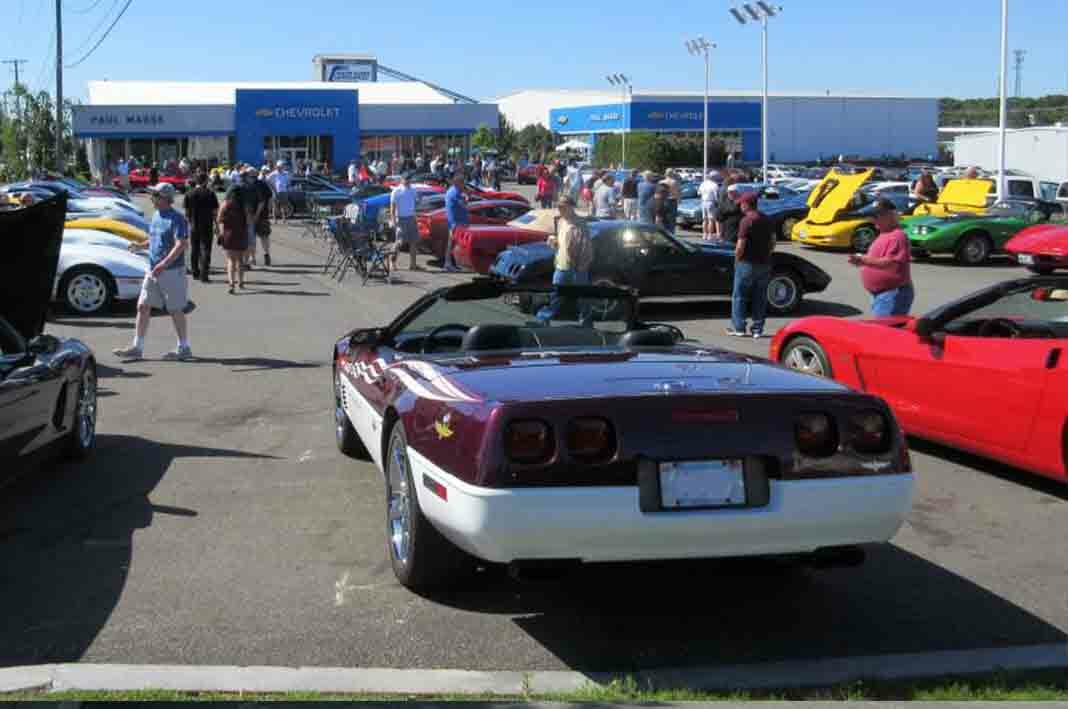Chevrolet will soon reach a milestone: 7 decades of a true American sports car. “And they call her “Corvette.”
Dave Garroway spoke those words…the first celebrity pitching Corvette. Garroway hosted NBC’s “Today Show” as Chevrolet began spreading word. Corvette was unlike anything GM had ever built. One young designer was so inspired at first sight that he contacted the company, looking to join its design team. His name: Zora Duntov. More on him later.
Debuted at “Motorama” in January, 1953 …Corvette began production June 30th. American as the red, white and blue, the only exterior color was Polo White, with a red interior and Chevy’s proven “blue-flame” 6 cylinder. Early sales were limited, but Corvette sparked imagination. She started at $3500; twice the price of a base Chevy.
1956 brought the first major changes. Gone were the tailfin lights, side “coves” arrived. Color choices grew to 6, from cascade green to aztec copper. Option choices were growing, too. Now, for instance, you could add power windows for an extra $60.
Corvettes caught on. They appeared on Perry Mason in ’57, Bonanza commercial breaks by 1959..and Martin Milner cemented Corvette’s free American spirit by driving one across country in the early 60s on CBS’s “Route 66.” By Corvette’s 10th anniversary…it was time to update. The “C1” would become “C2.”
Sharing styling from GM’s “Mako Shark” concept car, Corvette introduced an all-new body for ’63: “Sting Ray” (GM executive Bill Mitchell’s encounter with a real Mako Shark while skin diving had inspired the name.)
Among the debut features was a rear “split-window” championed by Mitchell. Zora Duntov, now Corvette’s lead designer, wasn’t a fan, but his objections were over-ruled. Corvette buyers had similar concerns…and for 1964, it was gone. By ’67, the Vette had become what many enthusiasts consider the ultimate in style and power, equipped with the “L88” 430-horsepower 427.

Sadly, the “C2” design would be the shortest-lived in the model’s history…but the next campaign said “Corvette ’68…All Different, All Over.” C3 had arrived. And it set a design tone for the next 15 years while increasing production numbers.
In the mid-1970s, mediocrity swept the auto industry but Corvette rode on as the one domestic car to which auto-enthusiasts still aspired. Even with big block engines and serious horsepower disappearing, Vette still captured the imagination. In celebration of the silver anniversary, it paced the 1978 Indianapolis 500…the price ? $13,650. For ’79, an all-time top yearly production total: 53,000+.
With the 1980s, another leap in design & technology was due. By the time the first C4 arrived, it was a little overdue. Expected in showrooms for ’83, delays pushed the debut back until Corvette had missed an entire model year, jumping from 1982 to 1984. TV ads boasted new developments; aluminum brake calipers, full glass hatchback and a choice of electronic or liquid crystal display dashboard. It was the first Vette without Duntov’s influence (he’d retired in ’75). Corvette, again, paced Indy in ’86 with another encore for 1995.
The millionth Vette sold in ’92.

As a new millennium approached, Chevrolet returned to the drawing board for a ground-up redesign on C5 Corvettes in 1997. The transmission moved toward the rear and a lighter-weight hydroform frame improved handling. Also on the ’97 ? A trunk…for the first time since 1962. Indy called again in 1998. Corvette reached its 50th anniversary model for 2003, available in gleaming “anniversary red metallic.” It was only the second time in history an American model had survived 50 years (Oldsmobile’s ’98” had been the other). By 2005, the C6 was coming.
Another element missing since 1962 was fixed headlights…and they returned with C6. More automotive news was made via computer-aided gear-selection. Better throttle response and improved suspension helped break the 4 second 0-60 acceleration mark. Sales stayed strong around 35,000…briefly breaking 40 for 2007.
C7 Corvettes hit showrooms a little late. Well, VERY late, actually. Work began as early as 2007, but a planned arrival of 2011 kept getting pushed back until 2014. Carbon fiber was new, alongside direct injection and paddle-shifters for the automatic transmission. Back was the name “Stingray” (gone since 1976). But, the biggest change was dropped, last-minute, when Chevy cancelled plans for a mid-engine design. C7 Corvettes sold with an average sticker price breaking $55,000 for the first time…and at the end, the final C7 brought $2.7 million for charity.

Today, C8 Corvettes have been rolling off assembly lines since July, 2019. Finally, the mid-engine layout is in production. Corvette can be ordered with up to 495 factory horsepower and for the first time, a retractable hardtop is optional. Production has been extended for the C8, with 2021s not expected til mid-December.
It all adds up to 8 body designs, countless special editions and just over 1.5 million examples of America’s “true sports car.”
And they call her “Corvette.”
“Cruisin” Bruce Palmer is a longtime New England broadcast personality and noted auto enthusiast. Weekdays, he can be found hosting mornings on 100 FM “the Pike,” Worcester’s Classic Hits station; while throughout the warm weather months, he hosts classic car shows & events all across RI and eastern Massachusetts. Find more at www.Cruisinbruce.com.





